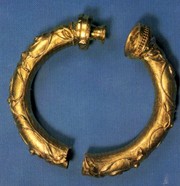Broighter Collar
History, Description: Celtic Iron Age Metalwork:
Masterpiece of Irish Goldsmithing.
![]()
|
Broighter Collar |
 The Broighter Collar (Torc) (The National Museum of Ireland) A masterpiece of Celtic goldsmithing. |
Broighter Collar (c.100-50 BCE)The luxuriously ornamented Broighter gold collar (torc), together with the Petrie Crown, is one of Ireland's surviving masterpieces of Celtic metalwork art from the Irish Iron Age. It was named after the townland Broighter in County Derry, where it was discovered by Thomas Nicholl in 1896 while ploughing on Joseph Gibson's field. The discovery of this exquisite item of precious metalwork helped to fuel the Celtic Art Revival Movement in England. Made by Irish metalworkers and goldsmiths during the first century BCE, the Broighter collar is a delicate tube of gold decorated in the La Tene style of Celtic art: a form influenced by Greek and Etruscan culture. Each end of the collar is buffer-shaped and fit together using a beautifully made T-shaped locking device. |
|
METALWORK OF THE
CELTS |
|
DESIGNS OF THE ANCIENT
CELTS |
Part of the Broighter Hoard The Broighter collar was only one of the items discovered in the so-called Broighter Hoard. Other gold artifacts in the gold hoard included a model boat, a small bowl, and other neck ornaments. The Broighter boat, a 10 cm long model of an Iron Age seagoing vessel was constructed from sheet gold and features an anchor, a mast, rowing benches, oars, and a boathook. Thomas Nicholl sold the Broighter Gold Hoard for a small price and the items duly found their way into the British Museum. However, in 1897, the Royal Irish Academy took legal action in the High Court, claiming that the find was "Treasure Trove." In 1903, the High Court agreed and the Broighter collection was placed in the Royal Irish Academy's collection in the National Museum of Ireland, where it remains to this day. Other examples of great Celtic metalwork include: the Derrynaflan Chalice, the Ardagh Chalice and the Moylough Belt Shrine, as well as the processional crosses like the famous Tully Lough Cross (8th/9th century) found in County Roscommon, and the Cross of Cong commissioned by Turlough O'Connor. Along with the magnificent medieval illuminated manuscripts, items of Celtic metalwork like the Broighter Torc represent an important step in the history of Irish art.
|
|
• For information about art and crafts
in Ireland, see: Irish Art Guide. ENCYCLOPEDIA OF IRISH GOLDSMITHERY AND METALWORK |